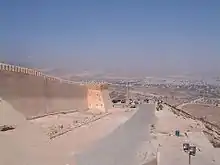Agadir Oufla
The Kasbah of Agadir Oufla[1] (Tashelhit: ⴰⴳⴰⴷⵉⵔ ⵓⴼⵍⵍⴰ, Agadir Uflla) is a historical landmark in Agadir, Morocco that housed the old city of Agadir, much of which was affected by the earthquake that struck the city. The fort is located on the top of a mountain rising 236 meters above sea level in the north of the town of Agadir near the current port.
قصبة أكادير أوفلا | |
 | |
| Location | Agadir |
|---|---|
| Beginning date | 16th century |
| Restored date | 2020 |
Name
Agadir Oufla[2] is the local name of the Kasbah of Agadir. The word "Agadir" means "fort", and "Oufla" is an Amazigh word meaning "above". Agadir Ofla, therefore, implies the fortress at the top.
History
Prior to the fortification of the site by the Sa'dis, the Portuguese nobleman João Lopes de Sequeira occupied the area in 1505.[3][4][5][6] He built a wooden castle at the foot of a hill[4] and a Portuguese colony named Santa Cruz do Cabo do Gué was created.[6] The castle was later bought by the King of Portugal in 1513.[4] Their presence elicited growing hostility from the local population of the Sous, until in 1540 the Sa'di sultan Muhammad al-Shaykh occupied the main hill above the city and installed artillery to prepare an attack on the Portuguese fortress below. The siege began in February 1541 and was successfully concluded in March.[4] The site was then left unoccupied for years until Muhammad's successor, Abdallah al-Ghalib (r. 1557–1574), built a new fortress on the hilltop.[4]
The Kasbah was destroyed for the first time in November 1755 during Lisbon earthquake, and again in 1960, during Agadir earthquake.
The Kasbah was renovated in 2020 under the instructions of King Mohammed VI.[7][8][9] On 8 September 2023, an earthquake struck the kasbah, which led to damages.[10]
Components of the fort before the 1960 earthquake
The fortress of the Kasbah of Agadir Ouflla before the earthquake consisted of:
- The outer wall is supported by towers and has a twisted door designed for defensive purposes.
- Great Mosque.
- Hospital.
- Treasury and postal building
- Houses, alleys and junior yards.
- Mallah, a Jewish neighborhood
- Shrines, the most important one is the mausoleum of Sidi Boudjemaa Aknaou.
- Mausoleum of Lala Yamna
Gallery
 Lighting walls Agadir Kasbah night
Lighting walls Agadir Kasbah night.jpg.webp) View from the hill to the port of Agadir
View from the hill to the port of Agadir View from the Kasbah of Agadir Oufla
View from the Kasbah of Agadir Oufla Agadir Kasbah Walls
Agadir Kasbah Walls Back of the walls of Agadir Oufella
Back of the walls of Agadir Oufella
References
- "Agadir Ofellah (The Kasbah) | Sites & Monuments of Agadir". Retrieved 2019-11-20.
- France, PASS Technologie, 26, rue Louis Braille, 75012 Paris. "Kasba d'Agadir Ighir (Oufella)". idpc.ma (in French). Archived from the original on 2020-07-05. Retrieved 2019-11-20.
{{cite web}}: CS1 maint: multiple names: authors list (link) - "Agadir | Morocco | Britannica". www.britannica.com. Retrieved 2022-12-18.
- Tourneau, Roger le (1960). "Agadir-Ighir". In Gibb, H. A. R.; Kramers, J. H.; Lévi-Provençal, E.; Schacht, J.; Lewis, B. & Pellat, Ch. (eds.). Encyclopaedia of Islam. Volume I: A–B (2nd ed.). Leiden: E. J. Brill. pp. 244–245. OCLC 495469456.
- Abun-Nasr, Jamil M. (1987). A History of the Maghrib in the Islamic Period. Cambridge University Press. pp. 207–208. ISBN 978-1-316-58334-0.
- Newitt, Malyn (2004). A History of Portuguese Overseas Expansion 1400–1668. Routledge. pp. 35–36, 66. ISBN 978-1-134-55304-4.
- Dardar, Jihad. "The Resurrection of Agadir Oufella, a Lost Moroccan Landmark". Morocco World News. p. 1.
- "بعد ترميمها .. "أكادير أوفلا" تستعد للافتتاح وولوج القصبة يودع المجانية". al3omk.com (in Arabic). 2023-05-24. Retrieved 2023-09-09.
- أكادير 24 (2023-05-26). "قصبة "أكادير أوفلا" تستعد لاستقبال زوارها بعد انتهاء أشغال الترميم". أكادير24 | Agadir24 (in Arabic). Retrieved 2023-09-09.
- Metz, Sam. "Powerful earthquake strikes Morocco, killing hundreds". www.timesofisrael.com. Retrieved 2023-09-09.